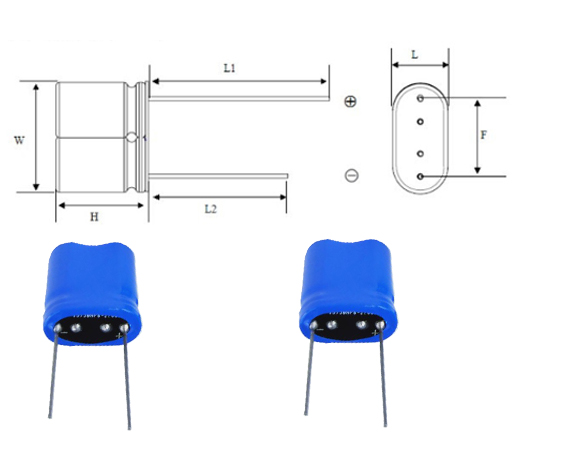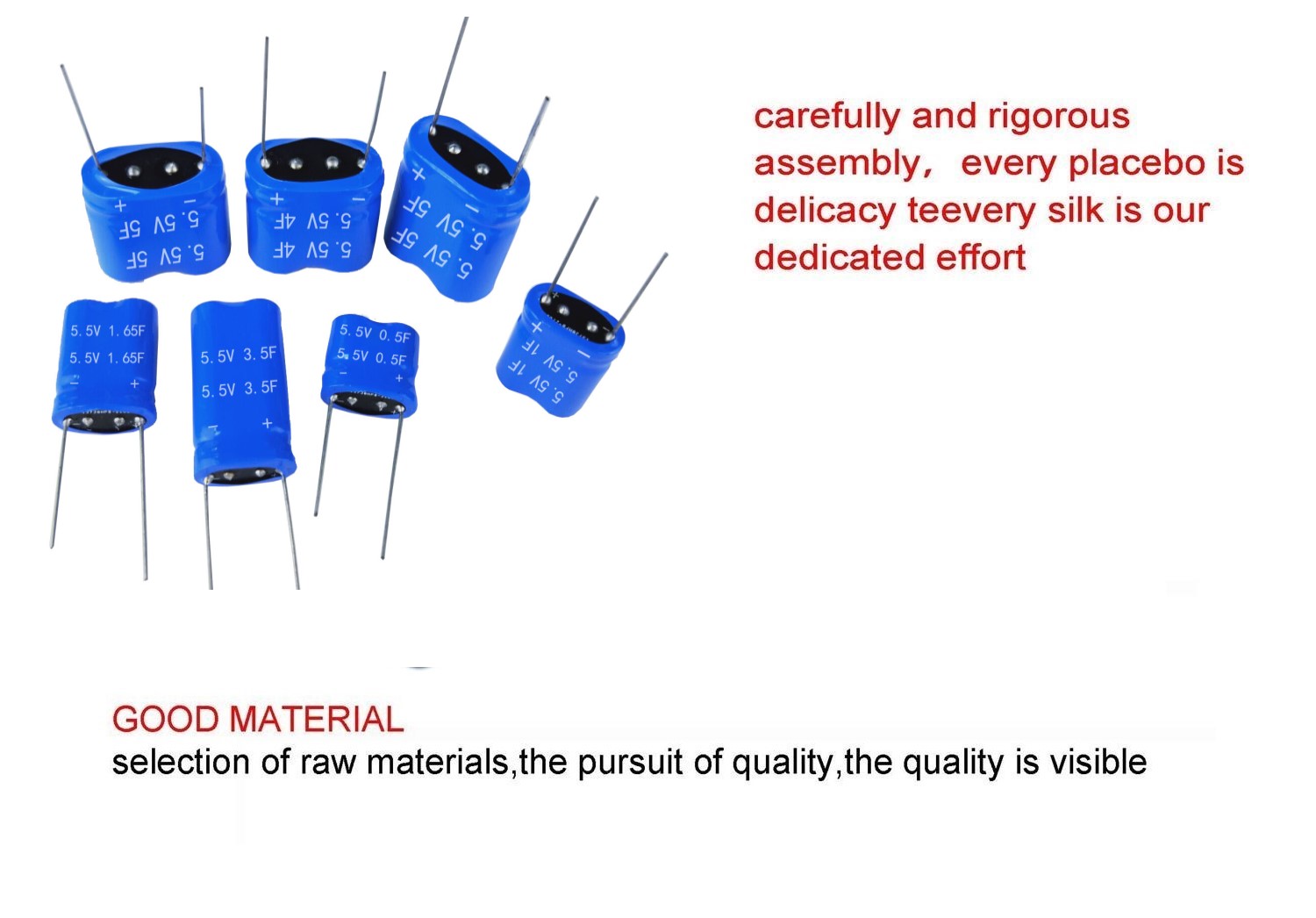Consulting phone:
135-3037-2041
(Mr.Wang)
Product introduction:
Under the dual influence of the domestic market and the international market, China's total import and export trade of electronic components continued to grow steadily. China has become a major producer of electronic components. The output of various products has leapt to the forefront of the world, and gradually occupies an important part of the global electronic component supply chain. Capacitor is also one of the products that account for a large proportion in the import and export trade of electronic components in China. The customs code of F supercapacitor in China is 853222, including "85322210 chip aluminum electrolytic capacitors" and "85322290 other aluminum electrolytic capacitors". The statistics on the import and export of aluminum electrolytic capacitors in China are made in the future.
Product specification:
project | characteristic |
| Rated voltage | 5.5V |
| Capacity | 1.65F |
| Operating temperature | - 40 ℃ - 65 ℃ |
| Tolerance | |
Temperature characteristic | from - 40 ℃ to 65 ℃ Capacity change: 30% of △ c ∠ initial measured value @ 25 ℃ Internal resistance change: 100% of △ ESR ∠ nominal value |
| High temperature load life | 25 ℃ and rated voltage, load 1500h capacity change: 30% of the initial measured value of △ c ∠ @ 25 ℃ internal resistance change: 100% of the nominal value of △ ESR ∠ |
| Normal temperature load life | 10 year capacity change of load under normal temperature load life of 25 ℃ and rated voltage: 30% of △ c ∠ initial measured value @ 25 ℃ internal resistance change: 100% of △ ESR ∠ nominal value |
| Normal temperature cycle life | of 25 ℃, the capacity change after 500000 charge discharge cycles (from rated voltage to 1/2 rated voltage): 30% of the initial measured value of △ c ∠ @ 25 ℃ internal resistance change: 100% of the nominal value of △ ESR ∠ |
| series | Rated voltage (V) | Electrostatic capacity (F) | DC internal resistance (m Ω) | AC internal resistance (m Ω) | Leakage current( mA72hrs@25 ℃) | size(W*L*H)mm |
| YKY | 5.5 | 1.65 | 200 | 180 | 0.014 | (W*L*H)mm |
Product size:

Purpose/application field:
As one of the core technologies of the Internet of Things, the selection and use of power supply is a key issue related to the trust and value of products. Although there are many existing power sources, power compensation and management of intelligent devices are particularly important due to various emergencies. With the help of lithium ion capacitors or ultrafast rechargeable batteries, they have fast response, ultra long life, high security and other characteristics. The following smart appliances and the Internet of Things can be applied in all aspects The supercapacitor can also be used as the backup power supply of intelligent appliances. When the main power supply fails to work properly, the supercapacitor can quickly supplement energy and provide instantaneous high power to support some pending actions.

Super capacitor customs code
Test method:
1. Electrostatic capacity tester
(1) Test principle
The electrostatic capacity of supercapacitor is measured by the method of constant current discharge of the capacitor and calculated according to the formula. C=It (U1-U2), where: C - electrostatic capacity, F; I - Constant discharge current, A; U1, U2 - voltage, V; Discharge time required from t-U1 to U2, S
(2) Test procedure
Charge the capacitor with a current of 100A until the capacitor is charged to the working voltage and the voltage is constant for 10 seconds, then discharge the capacitor with a current of 100A, taking U1 as 1.2VU2 as 1.0V, record the discharge time within the voltage range, the total circulating electrostatic capacity, and take the average
2. Storage energy
(1) Testing
The energy test of super capacitor is carried out by discharging the capacitor to 1/2 of the working voltage at constant power within the voltage range given by the capacitor. The output energy W of capacitor is obtained from the relationship between constant discharge power P and discharge time T, that is, W=P. T
(2) Test procedure
Charge the capacitor to the working voltage with a constant current of 100A, and then keep it constant until the charging current drops to the specified current (traction type 10A, starting type 1A). After 5 seconds of standstill, discharge the capacitor to 1/2 of the working voltage with a constant power, record the discharge time and calculate the value. Cycle 3 measurements and take the average value
3. Equivalent series resistance test (DC)
(1) Test principle
The internal resistance of the capacitor is measured according to the sudden change of voltage within 10ms after the capacitor disconnects the constant current charging circuit. In the formula: R-internal resistance of capacitor; U0 - Voltage before capacitor cut-off charging; Ui - Voltage within 10 ms after switching off charging; I - Cut off the current before charging.
(2) Measuring process
Charge the capacitor with a constant current of 100A, disconnect the charging circuit when 80% of the charging working voltage is reached, use a sampling machine to record the voltage change within 10 ms after the capacitor is powered off, calculate the internal resistance, repeat for 3 times, and take the average value.
4. Leakage current test
After the capacitor is charged to the rated voltage with a constant current of 100A, the capacitor is charged at this voltage for 30min at a constant voltage, and then it is left open for 72h. In the first three hours, record the voltage value every minute, and in the remaining time, record the voltage value every ten minutes.
Calculate the self discharge energy loss, SDLF=1 - (V/VW) 2, and the calculation time points are respectively 0.5,1,8,24,36,72h
Note: The voltage tester must have high input impedance to minimize the sound of the film.
Precautions:
Super capacitors cannot be used in the following states:
1) When the temperature of the capacitor exceeds the nominal temperature, the electrolyte will decompose, and the capacitor will generate heat, reduce its capacity, increase its internal resistance, and shorten its service life.
2) If the voltage exceeds the rated voltage, when the capacitor voltage exceeds the nominal voltage, the electrolyte will decompose. At the same time, the capacitor will generate heat, reduce its capacity, increase its internal resistance, and shorten its service life. Therefore, reducing the service voltage can improve the service life.
3) Loading of reverse voltage or AC voltage
1. The influence of ambient temperature on supercapacitors The service life of supercapacitors is affected by the service temperature. Generally, if the service temperature is increased by 10 ℃, the service life of supercapacitors will be shortened by half. Please try to use the supercapacitors in a low temperature environment lower than the service temperature. If it is used beyond the service temperature, it may cause sharp deterioration and damage of the characteristics. The use temperature of the super capacitor should not only confirm the ambient temperature and internal temperature of the equipment, but also confirm the radiation heat of the heater (power transistor, resistor, etc.) in the equipment, and the self heating temperature caused by ripple current. In addition, do not install the heater near the supercapacitor.
2. Please use the capacitor correctly according to the positive and negative pole marks.
3. Please avoid using super capacitors in the following environments. a) The environment is directly splashed with water, salt water and oil, or is in the state of condensation and full of gas like oil or salt. b) An environment full of harmful gases (hydrogen sulfide, sulfurous acid, chlorine, ammonia, bromine, methyl bromide, etc.). c) Environment splashed with acidic and alkaline solvents. d) Direct sunlight or dusty environment. e) An environment subject to excessive vibration and shock.
4. Avoid overheating the capacitor during welding (for 1.6mm printed circuit board, the welding temperature shall be 260 ℃, and the time shall not exceed 5s).
5. Please avoid conducting circuit wiring between the outgoing poles of the super capacitor or between the solder joints of the connecting plate.
6. Overvoltage, exceeding the operating temperature range and other conditions beyond the rated conditions may cause the pressure valve to act and the electrolyte will be ejected. Therefore, please adopt the design method that has considered the possible occurrence of this abnormal condition.
7. During fast charging and discharging, voltage drop (also called IR drop) caused by internal impedance will be generated at the beginning of charging and discharging. Therefore, please adopt the design method that has considered the voltage change range.
8. If the terminals of power type high-capacity products (products above 10F) are short circuited during charging, hundreds of amperes of current will flow through, which is dangerous. Do not install or remove the battery in the charged state.
9. Do not put the capacitor into the dissolved solder, only stick solder on the guide pin of the capacitor. Do not let the welding rod contact the capacitor heat shrink tube.
10. Do not twist or tilt the capacitor forcibly after installation.
11. When the supercapacitor is used in series, there is a problem of voltage balance between individual capacitors